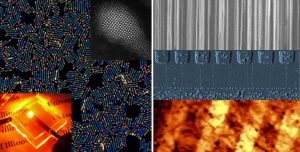Multifunctional Double Heterojunction Nanorod LEDs
(see also: https://youtu.be/EjAWpsNUSAQ)
Our research program aims to develop novel nanoscale materials and understand charging and charge separation/recombination phenomena occurring in them. Charging and charge separation/recombination are fundamental processes that govern how electronic, optoelectronic, and photovoltaic devices operate. Materials with nanometer dimensions provide new engineering paradigms and prospects for devices with unprecedented performance. However, ubiquitously large surface-to-volume ratio of materials in this size regime often leads to large deviations from the expected and therefore difficulties arise in achieving the desired performance. The ability to control surface and interfacial effects is then critical in elucidating the underlying materials’ properties which in turn is essential in developing any future technologies. Hence, we study how charging and charge separation/recombination processes affect structure, electrical and optical properties, and chemical reactivity with special attention to the materials’ responses to variations at surfaces and interfaces. Insights gained from these studies are then exploited to develop new materials exhibiting superior properties useful for solar energy conversion and high performance nano- and macro-electronics.
Current active areas of research include: